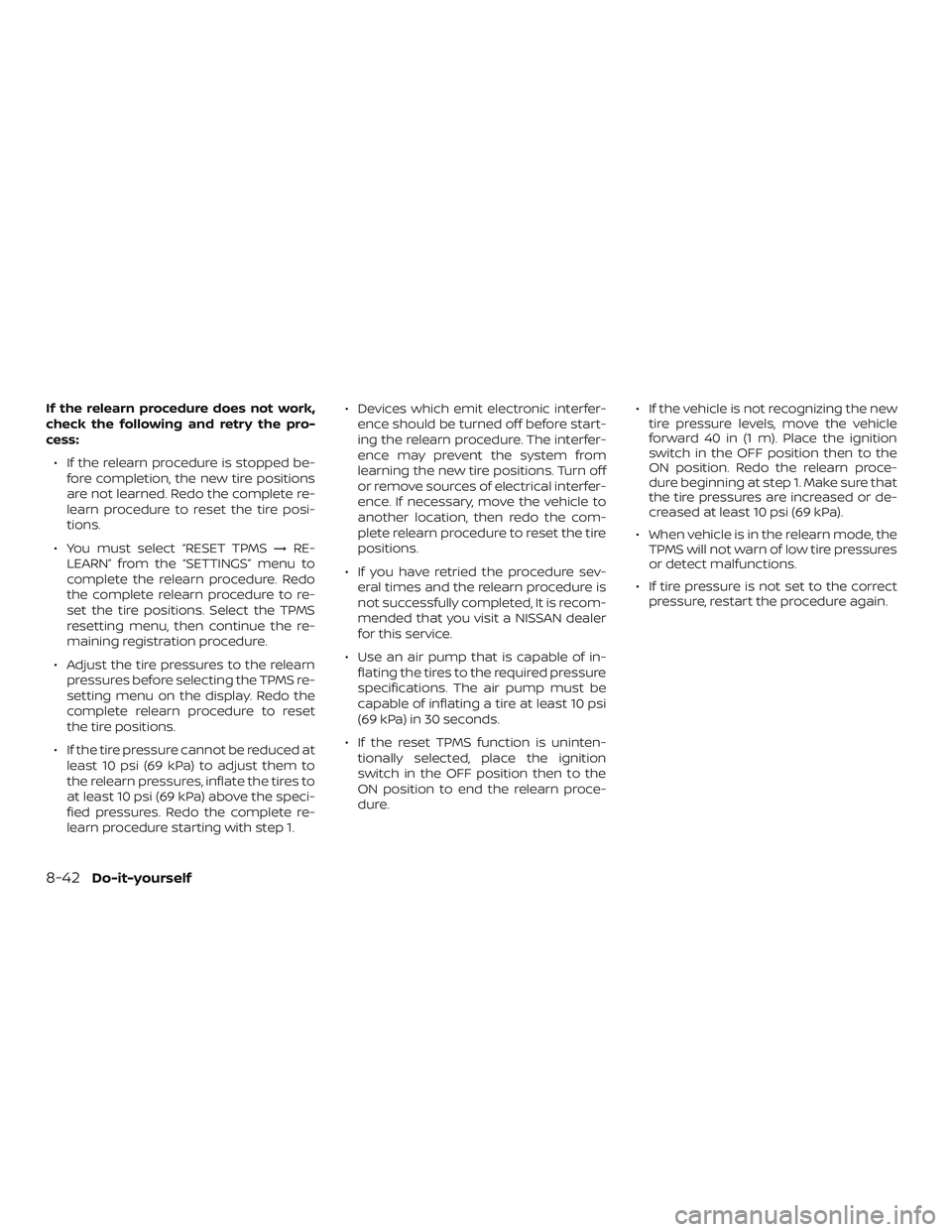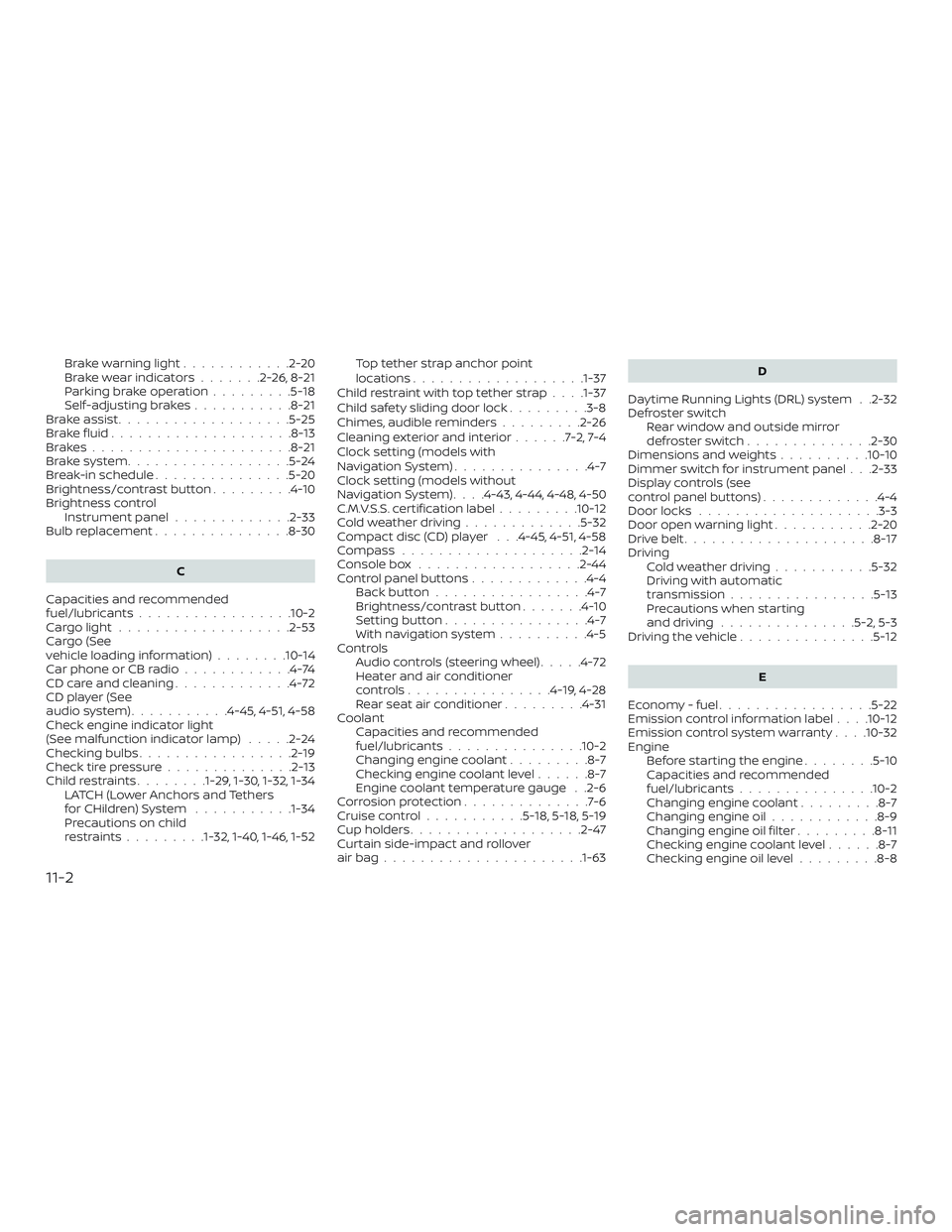Page 307 of 426

The wheel nuts must be kept tightened
to specification at all times. It is recom-
mended that wheel nuts be tightened to
specifications at each lubrication inter-
val.
Adjust tire pressure to the COLD pres-
sure.
COLD pressure: Af ter vehicle has been
parked for 3 hours or more or driven less
than 1 mile (1.6 km).
COLD tire pressures are shown on the
Tire and Loading Information label af-
fixed to the driver side center pillar.
Af ter adjusting tire pressure to the COLD
tire pressure, the display (if so equipped)
of the tire pressure information may
show higher pressure than the COLD tire
pressure af ter the vehicle has been
driven more than 1 mile (1.6 km). This is
because the tire pressure increases as
the tire temperature rises. This does not
indicate a system malfunction.5. Securely store the flat tire and jacking equipment in the vehicle.WARNING
∙ Always make sure that the spare tireand jacking equipment are properly
secured af ter use. Such items can be-
come dangerous projectiles in an ac-
cident or sudden stop.
∙ The spare tire is designed for emer- gency use. For additional information,
refer to “Wheels and tires” in the “Do-
it-yourself ” section of this manual. To start your engine with a booster, the
instructions and precautions below must
be followed.
WARNING
∙ If done incorrectly, jump starting can
lead to a battery explosion, resulting
in severe injury or death. It could also
damage your vehicle.
∙ Explosive hydrogen gas is always present in the vicinity of the battery.
Keep all sparks and flames away from
the battery.
∙ Do not allow battery fluid to come into contact with eyes, skin, clothing or
painted surfaces. Battery fluid is a
corrosive sulfuric acid solution which
can cause severe burns. If the fluid
should come into contact with any-
thing, immediately flush the con-
tacted area with water.
∙ Keep battery out of the reach of children.
∙ The booster battery must be rated at 12 volts. Use of an improperly rated
battery can damage your vehicle.
JUMP STARTING
6-10In case of emergency
Page 363 of 426

If the relearn procedure does not work,
check the following and retry the pro-
cess:∙ If the relearn procedure is stopped be- fore completion, the new tire positions
are not learned. Redo the complete re-
learn procedure to reset the tire posi-
tions.
∙ You must select “RESET TPMS →RE-
LEARN” from the “SETTINGS” menu to
complete the relearn procedure. Redo
the complete relearn procedure to re-
set the tire positions. Select the TPMS
resetting menu, then continue the re-
maining registration procedure.
∙ Adjust the tire pressures to the relearn pressures before selecting the TPMS re-
setting menu on the display. Redo the
complete relearn procedure to reset
the tire positions.
∙ If the tire pressure cannot be reduced at least 10 psi (69 kPa) to adjust them to
the relearn pressures, inflate the tires to
at least 10 psi (69 kPa) above the speci-
fied pressures. Redo the complete re-
learn procedure starting with step 1. ∙ Devices which emit electronic interfer-
ence should be turned off before start-
ing the relearn procedure. The interfer-
ence may prevent the system from
learning the new tire positions. Turn off
or remove sources of electrical interfer-
ence. If necessary, move the vehicle to
another location, then redo the com-
plete relearn procedure to reset the tire
positions.
∙ If you have retried the procedure sev- eral times and the relearn procedure is
not successfully completed, It is recom-
mended that you visit a NISSAN dealer
for this service.
∙ Use an air pump that is capable of in- flating the tires to the required pressure
specifications. The air pump must be
capable of inflating a tire at least 10 psi
(69 kPa) in 30 seconds.
∙ If the reset TPMS function is uninten- tionally selected, place the ignition
switch in the OFF position then to the
ON position to end the relearn proce-
dure. ∙ If the vehicle is not recognizing the new
tire pressure levels, move the vehicle
forward 40 in (1 m). Place the ignition
switch in the OFF position then to the
ON position. Redo the relearn proce-
dure beginning at step 1. Make sure that
the tire pressures are increased or de-
creased at least 10 psi (69 kPa).
∙ When vehicle is in the relearn mode, the TPMS will not warn of low tire pressures
or detect malfunctions.
∙ If tire pressure is not set to the correct pressure, restart the procedure again.
8-42Do-it-yourself
Page 419 of 426

Brakewarninglight............2-20
Brakewearindicators.......2-26,8-21
Parking brake operation.........5-18
Self-adjustingbrakes...........8-21
Brake assist ...................5-25
Brakefluid....................8-13
Brakes......................8-21
Brake system ..................5-24
Break-in schedule ...............5-20
Brightness/contrast button .........4-10
Brightness control Instrument panel .............2-33
Bulb replacement ...............8-30
C
Capacities and recommended
fuel/lubricants.................10-2
Cargolight...................2-53
Cargo (See
vehicle loading information) ........10-14
Car phone or CB radio ............4-74
CDcareandcleaning.............4-72
CD player (See
audio system) ...........4-45,4-51,4-58
Check engine indicator light
(See malfunction indicator lamp) .....2-24
Checking bulbs .................2-19
Check tire pressure ..............2-13
Childrestraints........1-29, 1-30, 1-32, 1-34 LATCH (Lower Anchors and Tethers
forCHildren)System ...........1-34
Precautions on child
restraints.........1-32, 1-40, 1-46, 1-52 Top tether strap anchor point
locations..................
.1-37
Child restraint with top tether strap . . . .1-37
Child safety sliding door lock .........3-8
Chimes, audible reminders .........2-26
Cleaningexteriorandinterior......7-2,7-4
Clock setting (models with
NavigationSystem)...............4-7
Clock setting (models without
NavigationSystem)....4-43,4-44,4-48,4-50
C.M.V.S.S. certification label .........10-12
Cold weather driving .............5-32
Compact disc (CD) player . . .4-45, 4-51, 4-58
Compass ....................2-14
Console box ..................2-44
Control panel buttons .............4-4
Back button .................4-7
Brightness/contrast button .......4-10
Settingbutton................4-7
Withnavigationsystem..........4-5
Controls Audio controls (steering wheel) .....4-72
Heater and air conditioner
controls................4-19,4-28
Rear seat air conditioner .........4-31
Coolant Capacities and recommended
fuel/lubricants...............10-2
Changing engine coolant .........8-7
Checking engine coolant level ......8-7
Engine coolant temperature gauge . .2-6
Corrosionprotection..............7-6
Cruisecontrol...........5-18,5-18,5-19
Cupholders...................2-47
Curtain side-impact and rollover
airbag..................... .1-63D
Daytime Running Lights (DRL) system . .2-32
Defroster switch Rear window and outside mirror
defrosterswitch..............2-30
Dimensions and weights ..........10-10
Dimmer switch for instrument panel . . .2-33
Display controls (see
control panel buttons) .............4-4
Door locks ....................3-3
Door open warning light ...........2-20
Drivebelt.....................8-17
Driving Coldweatherdriving...........5-32
Driving with automatic
transmission ................5-13
Precautions when starting
anddriving.............. .5-2, 5-3
Driving the vehicle ...............5-12
E
Economy - fuel .................5-22
Emission control information label . . . .10-12
Emission control system warranty . . . .10-32
Engine Before starting the engine ........5-10
C
apacities and recommended
fuel/lubricants...............10-2
Changing engine coolant .........8-7
Changing engine oil ............8-9
Changing engine oil filter .........8-11
Checking engine coolant level ......8-7
Checking engine oil level .........8-8
11-2